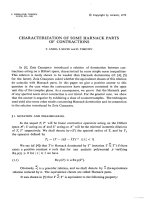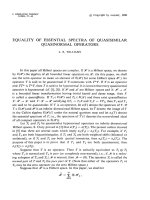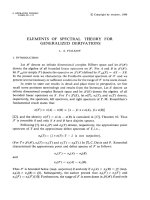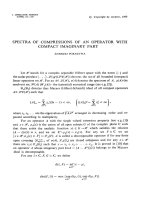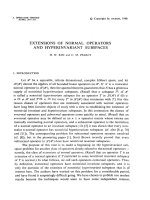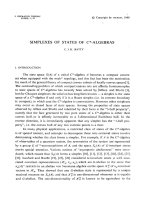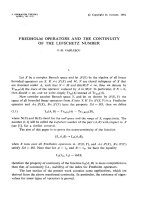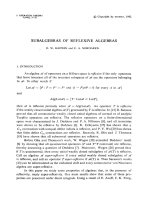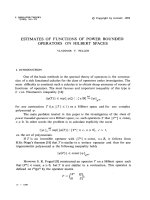Báo cáo toán học: "Combinatorics of Partial Derivatives" pdf
Bạn đang xem bản rút gọn của tài liệu. Xem và tải ngay bản đầy đủ của tài liệu tại đây (130.67 KB, 13 trang )
Combinatorics of Partial Derivatives
Michael Hardy
School of Mathematics
University of Minnesota, Minneapolis, MN 55455, USA
Submitted: Oct 1, 2005; Accepted: Dec 24, 2005; Published: Jan 7, 2006
Mathematics Subject Classifications: 05A15, 05A18, 11B73, 05-02
Abstract
The natural forms of the Leibniz rule for the kth derivative of a product and
of Fa`a di Bruno’s formula for the kth derivative of a composition involve the dif-
ferential operator ∂
k
/∂x
1
···∂x
k
rather than d
k
/dx
k
, with no assumptions about
whether the variables x
1
, ,x
k
are all distinct, or all identical, or partitioned into
several distinguishable classes of indistinguishable variables. Coefficients appearing
in forms of these identities in which some variables are indistinguishable are just
multiplicities of indistinguishable terms (in particular, if all variables are distinct
then all coefficients are 1). The computation of the multiplicities in this gener-
alization of Fa`a di Bruno’s formula is a combinatorial enumeration problem that,
although completely elementary, seems to have been neglected. We apply the results
to cumulants of probability distributions.
1 Introduction
Both the well-known Leibniz rule
d
k
dx
k
(uv)=
k
=0
k
d
u
dx
·
d
k−
v
dx
k−
(1)
and the celebrated formula of Francesco Fa`a di Bruno
d
k
dx
k
f(y)=
k!
1!
m
1
···k!
m
k
m
1
! ···m
k
!
f
(m
1
+···+m
k
)
(y)
j : m
j
=0
d
m
j
y
dx
m
j
(2)
(where the sum is over all k-tuples (m
1
, ,m
k
) of non-negative integers satisfying the
constraint m
1
+2m
2
+3m
3
+ ···+ km
k
= k) are formulas for kth derivatives of functions
of functions of x. That is what the left sides of these identities share in common. The
the electronic journal of combinatorics 13 (2006), #R1 1
right sides of both identities are sums whose terms have products of higher derivatives
with respect to x as factors.
All mathematicians know the combinatorial interpretation of the coefficients in the
Leibniz rule (the number of size- subsets of a size-k set), and all combinatorialists know
the combinatorial interpretation of the coefficients in Fa`a di Bruno’s formula (the number
of partitions of a size-k set into m
j
parts of size j, for j =1, ,k). However, the following
two points appear not to be widely known:
1. The natural form of these identities involves the differential operator
∂
k
∂x
1
··· ∂x
k
instead of d
k
/dx
k
. In that form, all coefficients on the right sides are 1.
2. There should be no assumptions about whether the variables x
1
, ,x
k
are all dis-
tinct, or all identical, or partitioned into several distinguishable classes of indis-
tinguishable variables. When some variables become indistinguishable, so do some
of the terms on the right sides of the identities. Indistinguishable terms then get
collected, so that each constant coefficient of a term on the right side is that term’s
multiplicity. When all of the variables are indistinguishable, then the multiplicities
are the coefficients in (1) and (2) above.
We will call the above Point 1 and Point 2.
Finding the multiplicities in Point 2 applied to (2) is a combinatorial problem that
may have escaped explicit treatment until the present paper, in which the solution is
Proposition 4. The problem is that of enumeration of what we will call “collapsing parti-
tions”.
As an example of Point 2, if x
2
and x
3
collapse into two indistinguishable variables
called x
2
,sothat∂
3
/(∂x
1
∂x
2
∂x
3
) becomes ∂
3
/(∂x
1
∂x
2
2
), then the two-term sum
∂y
∂x
2
·
∂
2
y
∂x
1
∂x
3
+
∂y
∂x
3
·
∂
2
y
∂x
1
∂x
2
collapses to the term
2 ·
∂y
∂x
2
·
∂
2
y
∂x
1
∂x
2
with multiplicity 2.
The chain rule and the product rule are enough to entail that the coefficients must be
positive integers. But without Point 1 and Point 2, it is not obvious what, if anything,
they enumerate.
Two papers, Constantine and Savits [5] and Leipnik and Reid [9], give an identity ex-
pressing (∂
k
1
+···+k
n
/∂x
k
1
1
···∂x
k
n
n
)f(y) as a linear combination of products of derivatives
of f(y) with respect to y and of y with respect to the independent variables. But neither
of those sources mentions that as more and more variables become indistinguishable the
the electronic journal of combinatorics 13 (2006), #R1 2
identity does not change except in the collection of newly indistinguishable terms. With-
out that observation, the combinatorial content of the problem is invisible. Leipnik and
Reid in [9], p. 1, wrote, “Obviously, ‘pure’ derivatives, such as
∂
4
G(z
1
,z
2
)
∂z
4
1
are easier to deal
with than mixed derivatives like
∂
4
G
∂z
2
1
∂z
2
2
.” But from our point of view, it will be maximally
“mixed” derivatives like ∂
4
G/(∂z
1
∂z
2
∂z
3
∂z
4
) that are the easiest and most basic.
Proposition 2 of this paper is partially anticipated by Terry Speed in [14], page 382.
That paper gives only the special case in which f is the exponential function, in which
the derivatives appear as coefficients of power series, and is stated in an inconspicuous
and somewhat tangential way that mixes it so thoroughly with the theory of cumulants
in probability theory that it can be understood only by understanding what the paper is
saying about cumulants. Speed wrote: “ the general results are most transparent when
all variables under discussion are taken to be distinct.” That remark played a role in
inspiring this paper. Its influence will be seen not only in our Proposition 1, but also
in our treatment of product rules–a topic not directly relevant to that of Speed’s paper
and not mentioned there. Speed went on: “The identification of some or all [variables]
at a later stage merely introduces extra factors, and at times these multiplicities are not
particularly easy to calculate.” The multiplicities are given by our Proposition 4.
Unlike [5] and [9], Warren Johnson [8] states a version of Fa`a di Bruno’s formula that
is explicit about the combinatorial meaning of the coefficients. But Johnson treats only
functions of one variable and gives nothing like Proposition 2 of the present paper. The
same is true of the “compositional formula” on page 3 of Richard P. Stanley’s treatise [15].
Like Speed, Stanley gives a power-series version of the formula. He mentions the name of
Fa`a di Bruno only in endnotes. One also finds a very combinatorics-flavored views of Fa`a
di Bruno’s formula in [19]. Other variations on the theme are in [10], [11], and [18].
We conclude this paper with the application of the results to cumulants.
2 Partial derivatives and partitions of sets
In the identity
∂
3
∂x
1
∂x
2
∂x
3
e
y
= e
y
∂
3
y
∂x
1
∂x
2
∂x
3
+
∂y
∂x
1
·
∂
2
y
∂x
2
∂x
3
+
∂y
∂x
2
·
∂
2
y
∂x
1
∂x
3
+
∂y
∂x
3
·
∂
2
y
∂x
1
∂x
2
+
∂y
∂x
1
·
∂y
∂x
2
·
∂y
∂x
3
,
(3)
where y is a function of x
1
,x
2
,x
3
, the terms correspond in an obvious way to the five
partitions of the set { 1, 2, 3 }. We will see that this holds generally: the partial derivative
(∂
n
/∂x
1
···∂x
n
)e
y
is e
y
times the sum whose terms correspond in just this way to the
partitions of the set { 1, ,n}. Using the notation (for example) ∂
3
y
j∈{ 2,4,9 }
∂x
j
to
mean ∂
3
y/ ∂x
2
∂x
4
∂x
9
,wecansay
∂
n
∂x
1
···∂x
n
e
y
= e
y
π
B∈π
∂
|B|
y
j∈B
∂x
j
(4)
the electronic journal of combinatorics 13 (2006), #R1 3
where the sum is over all partitions π of the set { 1, ,n} and the product is over all
of the parts B, or “blocks” as we will call them, of the partition π, and we denote the
number of members of any set S by |S|.
If we have f(y) instead of e
y
, then the orders of the derivatives of f must be mentioned.
The order of each derivative of f is just the number of blocks in the partition. This is the
first result that we will prove (in Section 3):
Proposition 1.
∂
n
∂x
1
···∂x
n
f(y)=
π
f
(|π|)
(y)
B∈π
∂
|B|
y
j∈B
∂x
j
. (5)
Example 1.
∂
3
∂x
1
∂x
2
∂x
3
f(y)= f
(y)
∂
3
y
∂x
1
∂x
2
∂x
3
1block;1stderivativeoff.
+ f
(y)
∂y
∂x
1
·
∂
2
y
∂x
2
∂x
3
+
∂y
∂x
2
·
∂
2
y
∂x
1
∂x
3
+
∂y
∂x
3
·
∂
2
y
∂x
1
∂x
2
2 blocks in each partition; 2nd derivative of f.
+ f
(y)
∂y
∂x
1
·
∂y
∂x
2
·
∂y
∂x
3
3 blocks; 3rd derivative of f.
.
Proposition 2. If some of the x
i
s become indistinguishable, then so do the corre-
sponding terms in the sum; nothing else changes.
This will also be proved in Section 3.
Example 2. Suppose that in Example 1, the two variables x
2
and x
3
become indis-
tinguishable from each other. Call them both x
2
.Thenwehave
∂
3
∂x
1
∂x
2
2
f(y)=
1block;1stderivativeoff.
f
(y)
∂
3
y
∂x
1
∂x
2
2
+
2 blocks in each partition; 2nd derivative of f.
f
(y)
∂y
∂x
1
·
∂
2
y
∂x
2
2
+2·
∂y
∂x
2
·
∂
2
y
∂x
1
∂x
2
↑
The multiplicity
of this term is 2.
+
3 blocks; 3rd derivative of f.
f
(y)
∂y
∂x
1
·
∂y
∂x
2
2
.
the electronic journal of combinatorics 13 (2006), #R1 4
The multiplicity mentioned above is how many formerly distinguishable terms get
collected to form that term. The problem of finding such multiplicities is treated in
Section 4. Applying the language of that section to Example 2, we would ask: how
many partitions of the set { 1, 2, 3 } collapse to the partition { 2 } + { 1, 2 } of the multiset
{ 1, 2, 2 } when the set { 1, 2, 3 } collapses to the multiset { 1, 2, 2 }, i.e., when the members
2 and 3 become indistinguishable? The answer in this case is 2.
3 Proofs of the first two Propositions
Proof of Proposition 1. This proof relies on this simple standard algorithm for con-
verting a list of all partitions of { 1, ,n} into a list of all partitions of { 1, ,n+1}:
1. To each partition of { 1, ,n}, add the 1-member-set { n +1} as a new block.
This gives a list of some of the partitions of { 1, ,n+1}.
2. To each block of each partition of { 1, ,n},addn + 1 as a new member of the
block. This gives a list of
π
|π| additional partitions of { 1, ,n+1}.
The union of these two lists clearly contains all partitions of { 1, ,n+1}.
In particular, it works when n = 0, since the empty set has exactly one partition
1
.
That establishes the basis for a proof by mathematical induction on n.
Next we use the Proposition in case n to prove the Proposition in case n +1.
∂
n+1
∂x
1
···∂x
n+1
f(y)
=
π
∂
∂x
n+1
f
(|π|)
(y)
B∈π
∂
|B|
y
j∈B
∂x
j
=
π
f
(|π|+1)
(y)
∂y
∂x
n+1
B∈π
∂
|B|
y
j∈B
∂x
j
+ f
(|π|)
(y)
∂
∂x
n+1
B∈π
∂
|B|
y
j∈B
∂x
j
=
π
f
(|π|+1)
(y)
∂y
∂x
n+1
B∈π
∂
|B|
y
j∈B
∂x
j
+f
(|π|)
(y)
B∈π
∂
|B|+1
y
∂x
n+1
j∈B
∂x
j
·
C∈π : C=B
∂
|C|
y
j∈C
∂x
j
.
1
Perhaps as a result of studying set theory, I was surprised when I learned that some respectable
combinatorialists consider such things as this to be mere convention. One of them even said a case could
be made for setting the number of partitions to 0 when n = 0. By stark contrast, Gian-Carlo Rota wrote
in [13], p. 15, that “the kind of mathematical reasoning that physicists find unbearably pedantic” leads
not only to the conclusion that the elementary symmetric function in no variables is 1, but straight from
there to the theory of the Euler characteristic, so that “such reasoning does pay off.” The only other
really sexy example I know is from applied statistics: the non-central chi-square distribution with zero
degrees of freedom, unlike its “central” counterpart, is non-trivial.
the electronic journal of combinatorics 13 (2006), #R1 5
Inside the last square brackets is a sum of two terms. The first term corresponds to step 1
in our algorithm: we have added { n +1} as a new block to our partition π of { 1, ,n},
getting a partition with |π| + 1 blocks, of the set { 1, ,n+1}. The second corresponds
to step 2 in our algorithm: we have added n + 1 to each block of our partition π of
{ 1, ,n}, getting a partition with |π| blocks, of the set { 1, ,n+1}.Wenowhavea
sum over all partitions of { 1, ,n+1}, each partition being represented as a product
of partial derivatives, each partial derivative representing a block. And for each partition
there is a factor f
(•)
(y), the order of the derivative being the number of blocks of the
partition. This proves case n + 1, and the proof by induction on n is complete.
ProofofProposition2.Observe that if, in the argument above, we had differenti-
ated at the (n + 1)th step with respect to x
k
for some k ∈{1, ,n}, rather than with
respect to x
n+1
, then nothing would change except that some formerly distinguishable
terms would become indistinguishable.
4 Multisets and collapsing partitions
4.1 Definitions and conventions
The first two bullet points and the fifth in the definition below are standard but make clear
which notational conventions we will follow. The third and fourth may be less standard.
• A multiset is a “set with multiplicities”, i.e., positive integers, assigned to each
member x, thought of as the number of times x occurs as a member. We will
write { x
1
, ,x
1
m
1
, ,x
n
, ,x
n
m
n
}, indicating multiplicities with underbraces, or, in
simple cases, for example { a, a, a, b, b, c, c, c, c, c }, the multiplicity being the number
of times the member is named. In particular, we identify every set with a multiset
in which every multiplicity is 1.
Perhaps the most widely known example is the multiset of prime factors of a natural
number: each prime factor has a multiplicity.
• The size |S| ofamultisetS is the sum of the multiplicities.
• The sum of multisets is given by term-by-term addition of multiplicities:
{ x
1
, ,x
1
1
, ,x
n
, ,x
n
n
} + { x
1
, ,x
1
m
1
, ,x
n
, ,x
n
m
n
}
= { x
1
, ,x
1
1
+m
1
, ,x
n
, ,x
n
n
+m
n
} .
Only when sets are disjoint is their sum the same as their union.
• A partition of a multiset expresses that multiset as a sum of multisets.
• A partition of a positive integer expresses that integer as a sum of positive integers.
the electronic journal of combinatorics 13 (2006), #R1 6
The next proposition is trivial but crucial.
Proposition 3.
• The concept of partition of a set is a special case of that of partition of a multiset.
• If we identify any multiset in which “all members are equal” (i.e., there is just one
member, whose multiplicity may be any positive integer) with the multiplicity of
that one member (for example, the multiset { a, a, a } is identified with the number
3), then the concept of partition of an integer becomes a special case of that of
partition of a multiset.
4.2 Collapsing partitions
If the members 1, 2, 3, 4 of the set { 1, 2, 3, 4, 5, 6, 7, 8 } are made indistinguishable from
each other and are called “1”, and 5 and 6 are made indistinguishable from each other
and are called “5”, then we say that the set { 1, 2, 3, 4, 5, 6, 7, 8 } has “collapsed” to the
multiset { 1, 1, 1, 1, 5, 5, 7, 8 }. Then we can ask: how many set-partitions collapse to the
multiset-partition
{ 1, 1, 5 } + { 1, 1, 5 } + { 7, 8 } ?
It is a simple exercise to find that the answer is 6. Consequently, via the correspondence
τ = { 1, ,1
k
1
, ,n, ,n
k
n
}←→
∂
k
1
+···+k
n
∂x
k
1
1
···∂x
k
n
n
= ∂
τ
(6)
between multisets and partial differential operators, Proposition 2 entails that the expan-
sion of the partial derivative
∂
{ 1,1,1,1,5,5,7,8 }
f(y)=
∂
8
∂x
4
1
∂x
2
5
∂x
7
∂x
8
f(y)(7)
contains (among many others) this term:
6f
(y)
∂
{ 1,1,5 }
y
2
∂
{ 7,8 }
y =6f
(y)
∂
3
y
∂x
2
1
∂x
5
2
·
∂
2
y
∂x
7
∂x
8
(8)
(the order of the derivative of f is 3 because that is how many blocks are in this partition).
An extreme case of “collapsing” is exemplified by the question: How many partitions
of the set { 1, 2, 3, 4, 5, 6, 7, 8 } collapse to the partition 3 + 3 + 2 of the number 8 when
all 8 members of the set { 1, 2, 3, 4, 5, 6, 7, 8 } collapse into indistinguishability? Again, a
simple exercise shows that the answer is 280. In this extreme case where all members of
the set become indistinguishable and partitions of the multiset become partitions of an
integer, the answer to the problem of enumeration of collapsing partitions is well known
to be given by the coefficients in Fa`a di Bruno’s formula – in this case by the coefficient
of
f
(y)
d
3
y
dx
3
2
d
2
y
dx
2
the electronic journal of combinatorics 13 (2006), #R1
7
in the expansion of (d
8
/dx
8
)f(y).
In general, we have this result:
Corollary to Propositions 1 and 2. Let τ = { 1, ,1
k
1
, ,n, ,n
k
n
}.Usethe
notation introduced in (6) above. Then
∂
τ
f(y)=
∂
k
1
+···+k
n
∂x
k
1
1
···∂x
k
n
n
f(y)=
τ
1
+τ
2
+···
Mf
(•)
(y) · (∂
τ
1
y · ∂
τ
2
y · ···) ,
where the sum is over all partitions τ
1
+τ
2
+··· of the multiset τ, the order of the derivative
f
(•)
(y) is the number of terms in the partition τ
1
+ τ
2
+ ···, and the multiplicity M is the
number of partitions of the set { 1, 2, 3, ,k
1
+ ···+ k
n
} that collapse to the partition
τ
1
+ τ
2
+ ··· of the multiset τ when the set { 1, 2, 3, ,k
1
+ ···+ k
n
} collapses to the
multiset τ .
In order to use it in the next result, we introduce a convention:
Notational convention. For any multiset σ let σ!! denote the product of the facto-
rials of the multiplicities of the members of σ. For example, { 1, 1, 1, 1, 2, 2, 2 }!! = 4!3! =
144.
The next result will be proved in Section 5:
Proposition 4.
Let τ = { 1, ,1
k
1
, ,n, ,n
k
n
}. Consider a partition
τ = τ
1
+ ···+ τ
1
m
1
+ τ
2
+ ···+ τ
2
m
2
+ ···
in which τ
1
, τ
2
, are all distinct (so that m
1
,m
2
,m
3
, are multiplicities of yet another
sort). Denote this by
τ = m
1
τ
1
+ m
2
τ
2
+ ··· .
Then the number of partitions of the set { 1, 2, 3, ,k
1
+ ···+ k
n
} that collapse to the
partition m
1
τ
1
+m
2
τ
2
+m
3
τ
3
+··· of the multiset τ when the set { 1, 2, 3, ,k
1
+ ···+ k
n
}
collapses to the multiset τ is
k
1
! ···k
n
!
τ
1
!!
m
1
τ
2
!!
m
2
τ
3
!!
m
3
···m
1
!m
2
!m
3
! ···
. (9)
4.3 The most extreme case
In the most extreme case of indistinguishability of independent variables, the operator
∂
k
/∂x
1
···∂x
k
collapses to d
k
/dx
k
:
d
k
dx
k
f(y)=
π
f
(|π|)
(y)
B∈π
d
dx
|B|
y, (10)
the electronic journal of combinatorics 13 (2006), #R1 8
where, again, the sum is over all partitions π of { 1, ,k}. In this sum, two terms are
indistinguishable whenever two partitions of the set { 1, ,k} both collapse to the same
partition of the integer k when all of the members of { 1, ,k} become indistinguishable.
In this extreme case, the multiplicities are given by the classic formula of Francesco
Fa`a di Bruno (2). Francesco Fa`a di Bruno (1825 – 1888) was (in chronological order) a
military officer, a mathematician, and a priest. He published this formula in [2] and [3]
and was posthumously beatified by the Pope
2
.
Alex Craik’s Prehistory of Faa di Bruno’s Formula [6] points out that Fa`a di Bruno
was anticipated in 1800 by L.F.A. Arbogast; see [1].
Although (2) is the well-known form of this identity, Warren P. Johnson has writ-
ten in [8] (bottom of page 231), that (10) “is really the fundamental form” of Fa`adi
Bruno’s formula. We propose that the conjunction of our first two Propositions is more
fundamental.
4.4 Conservation of Bell numbers
By now it should be clear that, when the derivative
∂
n
··· ···
f(y)
is expanded as a sum in terms of derivatives of f(y) with respect to y and derivatives of y
with respect to whichever independent variables appear, then the sum of the coefficients
is always the number B
n
of partitions of a set of n members. This is called the nth Bell
number, in honor of Eric Temple Bell. The first several of these are B
0
=1,B
1
=1,B
2
=
2,B
3
=5,B
4
=15,B
5
=52,B
6
= 203,B
7
= 877,B
8
= 4140, For an account of these
numbers, see [12]. As more and more of the n independent variables get identified with
each other, the sum of the multiplicities never changes.
5 Proof of Proposition 4
Imagine k
1
+ ···+ k
n
Scrabble tiles. On the first k
1
of these, the number “1” is written;
on the next k
2
of them, “2” appears; and so on. These are partitioned into m
1
copies of
the multiset τ
1
, m
2
copies of τ
2
,andsoon.
Permuting the k
1
“1”s or the k
2
“2”s, etc., does not alter the set of m
1
+ ···+ m
n
“words”. Thus there are k
1
! ···k
n
! permutations of the k
1
+ ···+ k
n
tiles representing the
partition
τ = m
1
τ
1
+ m
2
τ
2
+ ··· .
Permuting the identical elements within any block of this partition does not alter which
partition of τ we have, and therefore the product k
1
! ···k
n
! gets divided by τ
1
!!
m
1
τ
2
!!
m
2
···.
Neither does permuting the m
i
blocks identical to τ
i
, and therefore it also gets divided by
m
1
! ···m
n
!.
2
An anonymous referee suggests that that pontiff may have been influenced more by Fa`a di Bruno’s
charitable than mathematical work.
the electronic journal of combinatorics 13 (2006), #R1 9
6 Product rules
In the identity
∂
3
∂x
1
∂x
2
∂x
3
(uv)
= u ·
∂
3
v
∂x
1
∂x
2
∂x
3
+
∂u
∂x
1
·
∂
2
v
∂x
2
∂x
3
+
∂u
∂x
2
·
∂
2
v
∂x
1
∂x
3
+
∂u
∂x
3
·
∂
2
v
∂x
1
∂x
2
+
∂
2
u
∂x
1
∂x
2
·
∂v
∂x
3
+
∂
2
u
∂x
1
∂x
3
·
∂v
∂x
2
+
∂
2
u
∂x
2
∂x
3
·
∂v
∂x
1
+
∂
3
u
∂x
1
∂x
2
∂x
3
· v,
the terms correspond in an obvious way to the eight subsets of the set { 1, 2, 3 }.This
exemplifies the first part of our next result.
Proposition 5.
•
∂
n
∂x
1
···∂x
n
(uv)=
S
∂
(|S|)
u
j∈S
∂x
j
·
∂
(n−|S|)
v
j∈S
∂x
j
,
where the index S runs through the set of all subsets of { 1, ,n}.
• If some of the variables become indistinguishable, then so do some of the terms in
the sum; nothing else changes.
Example 4.
∂
3
∂x
1
∂x
2
2
(uv)=u ·
∂
3
v
∂x
1
∂x
2
2
+
∂u
∂x
1
·
∂
2
v
∂x
2
2
+2·
∂u
∂x
2
·
∂
2
v
∂x
1
∂x
2
+2 ·
∂
2
u
∂x
1
∂x
2
·
∂v
∂x
2
+
∂
2
u
∂x
2
2
·
∂v
∂x
1
+
∂
3
u
∂x
1
∂x
2
2
· v.
In this case the solution of the combinatorial problem is simpler:
Proposition 6.
∂
k
1
+···+k
n
∂x
k
1
1
··· ∂x
k
n
n
(uv)=
k
1
1
=0
···
k
n
n
=0
k
1
1
···
k
n
n
∂
1
+···+
n
u
∂x
1
1
··· ∂x
n
n
·
∂
k
1
−
1
+···+k
n
−
n
v
∂x
k
1
−
1
1
··· ∂x
k
n
−
n
n
.
In the most extreme case, all of the independent variables become indistinguishable, and
we have the familiar Leibniz rule (1). The proofs of Propositions 5 and 6 are left as
exercises.
As far as the present writer knows, the second part of Proposition 5 is new. It identifies
the easy combinatorial problem that Proposition 6 solves. Proposition 6 can be found in
both [5] and [4], p. 131, but without the combinatorial interpretation of the coefficients.
The first part of Proposition 5 is an important special case of Proposition 6, and we do
not know of any earlier explicit statement of it than that in the present paper (a referee
says “it could be just about anywhere” and I have not succeeded in proving otherwise).
the electronic journal of combinatorics 13 (2006), #R1 10
7 Cumulants
The omitted fragment represented by the second ellipsis “ ” in the first quote from
Terry Speed in Section 1 is the word random. That is because Speed’s topic is that of
cumulants of random variables.
For positive integers n,thenth cumulant functional κ
n
assigns a real number κ
n
(X)
to real-valued random variables X.Letµ =E(X) be the expected value of X. Then the
nth central moment of X is E((X − µ)
n
). For n ≥ 2, the nth cumulant shares with the
nth central moment the properties of nth-degree homogeneity and translation-invariance:
κ
n
(cX)=c
n
κ
n
(X),
κ
n
(X + c)=κ
n
(X).
Moreover, if the random variables X
1
, ,X
m
are independent, then
κ
n
(X
1
+ ···+ X
m
)=κ
n
(X
1
)+···+ κ
n
(X
m
).
The nth central moment has this additivity property only when n ≤ 3. In fact, when n =
either 2 or 3, the cumulant is just the central moment. When n = 1, then the cumulant is
the expected value. For all n,thenth cumulant is an nth-degree polynomial in the first
n moments.
Cumulants were introduced in the 19th century in [16] by the Danish actuary Thorvald
Thiele, who called them half-invariants; an English translation was published in 1931; see
[17]. They were first publicly given the name cumulants in 1931 by the statisticians Ronald
Fisher and John Wishart in [7], the name having been suggested to Fisher in private
correspondence from the statistician Harold Hotelling. There are also joint cumulants
κ(X
1
, ,X
n
).
When n = 2, this is just the covariance. All probabilists and statisticians know that the
covariance between a random variable and itself is its variance. A similar thing happens
with joint cumulants: When the n random variables collapse into indistinguishability,
then the joint cumulant coincides with the nth cumulant of one random variable:
κ( X, ,X
n
)=κ
n
(X).
Beyond this talk of “collapsing into indistinguishability”, a parallel between cumulants
and the partial derivatives treated in the foregoing sections is seen in the identity that
expresses the nth raw moment E(X
n
)(notthenth central moment) in terms of the first
n cumulants:
E(X
n
)=
π
B∈π
κ
|B|
(X). (11)
For random variables X
1
, ,X
n
, a similar identity holds:
E(X
1
···X
n
)=
π
B∈π
κ(X
i
: i ∈ B). (12)
the electronic journal of combinatorics 13 (2006), #R1 11
The identities (11) and (12) completely characterize all of the cumulant functionals.
That is how Terry Speed came to consider the question of these multiplicities, of which
all he wrote was that they are not always easy to calculate. Workers with cumulants know
what to do in the two opposite extreme cases: when none of the random variables are
identified then all coefficients are equal to 1, and when all are identified then the classic
Fa`a di Bruno formula (2) gives the coefficients. But if one were to judge by Speed’s
comments, they might seem at something of a loss in cases intermediate between “all”
and “none”. That case is handled by our Proposition 4.
Speed’s topic and that of partial derivatives are not two disparate applications of our
Proposition 4. The joint cumulant may be characterized as the coefficient of t
1
···t
n
in
the power-series expansion of
log E (exp(t
1
X
1
+ ···+ t
n
X
n
))
(at least in the case in which all moments exist). More tersely stated, the joint cumulant-
generating function is the logarithm of the joint moment-generating function. Since the
coefficients of a power series of the form
i
1
, ,i
n
c
i
1
, ,i
n
t
i
1
1
···t
i
n
n
/(i
1
! ···i
n
!) are its partial
derivatives at t
1
= ···= t
n
= 0, Speed’s topic is a special case of ours.
8 Acknowledgments
Ezra Miller and Jay Goldman offered helpful suggestions. Unlike some copyeditors, Ellen
Stuttle found the actual content interesting. Alex Craik pointed out some relevant refer-
ences and reminded me of Arbogast’s anticipation of Fa`a di Bruno’s formula. In addition
to some encouraging words, Doron Zeilberger pointed out his paper [19]; which is even
more “discretely” oriented than the present paper (which, the reader will have noticed,
disdains even to mention such “analytical” things as differentiability).
References
[1] L.F.A. Arbogast, Du Calcul des D´erivations, Levrault, Strasbourg, 1800.
[2] F. Fa`a di Bruno, Sullo Sviluppo delle Funzioni, Annali di Scienze Matematiche e
Fisiche 6, 1855 pp. 479-480.
[3] F. Fa`a di Bruno, Note sur un nouvelle formule de calcul diff´erentiel, Quarterly Journal
of Pure and Applied Mathematics, 1, 1857, pp. 359-360.
[4] L. Comtet, Advanced Combinatorics: The Art of Finite and Infinite Expansions,
Reidel, Dordrecht-Holland/Boston, 1974.
[5] G.M. Constantine and T.H. Savits, A Multivariate Faa di Bruno Formula with Appli-
cations, Transactions of the American Mathematical Society, 348, 1996 pp. 503-520.
the electronic journal of combinatorics 13 (2006), #R1 12
[6] A. Craik, Prehistory of Faa di Bruno’s Formula, American Mathematical Monthly,
112 (2), February 2005, pp. 119–130.
[7] R.A. Fisher and J. Wishart, The derivation of the pattern formulae of two-way parti-
tions from those of simpler patterns, Proceedings of the London Mathematical Society,
Series 2, 33, 1931, pp. 195-208.
[8] W.P. Johnson, The Curious History of Fa`a di Bruno’s Formula, Am. Math. Monthly
109, 2002, pp. 217-227.
[9] R. Leipnik and T. Reid, Multivariable Faa di Bruno Formulas, Electronic Proceedings
of the Ninth Annual International Conference on Technology in Collegiate Mathemat-
ics, http:// archives.math.utk.edu/ICTCM/EP-9.html#C23 .
[10] R. Mishkov, Generalization of the Formula of Faa di Bruno for a Composite Function
with a Vector Argument, International Journal of Mathematical Sciences, 24, 2000,
pp. 481-491.
[11] S. Noschese and P.E. Ricci, Differentiation of Multivariable Composite Functions
and Bell Polynomials, Journal of Computational Analysis and Applications, 5, 2003,
pp. 333-340.
[12] G-C. Rota, The Number of Partitions of a Set, Am. Math. Monthly 71, 1964, pp. 498-
504.
[13] C-C. Rota, Geometric Probability, Mathematical Intelligencer, 20 (4), 1998, pp. 11-
16.
[14] T.P. Speed, Cumulants and Partition Lattices, Australian Journal of Statistics, 25
(2), 1983, pp. 378-388.
[15] R.P. Stanley, Enumerative Combinatorics, Volume 2, Cambridge University Press,
Cambridge, 1999.
[16] T.N. Thiele, Forlæsinger over Almindelig Iagttagelselære, Reitzel, Copenhagen, 1889.
[17] T.N. Thiele, Theory of Observations, Layton, London, 1903. Reprinted in Annals of
Mathematical Statistics, 2, 1931, pp. 165-308.
[18] W.C. Yang, Derivatives are Essentially Integer Partitions, Discrete Mathematics,
222, 2000, pp. 235-245.
[19] D. Zeilberger, “Toward a Combinatorial Proof of the Jacobian Conjecture”, in Lecture
Notes in Mathematics v. 1234, Combinatoire
´
Enum´erative, Springer-Verlag, Berlin,
1986.
the electronic journal of combinatorics 13 (2006), #R1 13

